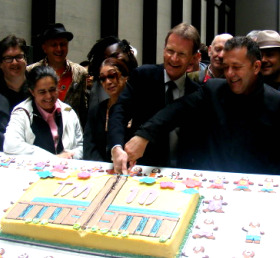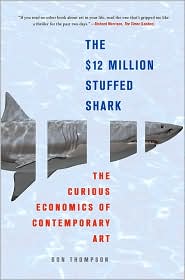The Tate Modern is having its 10th anniversary this week. Starting Friday, it’s hosting a three-day arts festival, and it’ll stay open until midnight on Friday and Saturday.
 Unquestionably, the Tate Modern is a success. It draws 5 million visitors a year, and more important it has affected culture in the U.K.
Unquestionably, the Tate Modern is a success. It draws 5 million visitors a year, and more important it has affected culture in the U.K.
Before the Tate Modern opened, London had no great museum of modern art. Britain lagged behind other European countries, not to mention the U.S. As AFP reported, Michael Craig Martin, a former Tate trustee and a conceptual artist, said that people liked it immediately, and surprisingly.
“It’s hard not to remember just how much suspicion and unease there was about contemporary art before, whereas now it’s everywhere — it has become a part of the cultural life of the country in a way that was unimaginable 20 years ago, and the Tate has played a very big part in that,” he told the Daily Telegraph.
“I don’t think anybody imagined it would be as successful as it was. But from the minute the doors opened, people liked the place. It feels welcoming.”
In fact, today there was a children’s procession from Borough Market to the museum, led by a samba band (above) and concluding with a cake-cutting ceremony where Nicholas Serota, the director, cut the cake. Sounds like great fun (except perhaps that the parents of some children might not want their kids to see some of the art at the Tate Modern, but that’s another story).
 To my mind, the Tate Modern should be a bigger museum role model than the Guggenheim Bilbao, which has succeeded for complex reasons — not just because it’s a museum-building-as-destination. (For example, the new Pompidou Metz.)
To my mind, the Tate Modern should be a bigger museum role model than the Guggenheim Bilbao, which has succeeded for complex reasons — not just because it’s a museum-building-as-destination. (For example, the new Pompidou Metz.)
Now, though, the Tate is planning a £215 million expansion that’s expected to open in 2012.
Several days ago, the Guardian previewed the 10th anniversary with a good story and a Q&A session with Serota, with questions asked both by art-world professionals and the public. Here is how he answered the expansion question:
Anyone who visits at weekends knows how overcrowded the gallery is. Anyone who tries to subscribe to our learning programmes knows they are wildly oversubscribed. So we have to grow. Every museum of modern art has grown in the last 20 or 30 years…. We have an expanding collection and need to have space to show that collection. If we don’t grow, people will stop giving us things?
Fair enough. Regular readers know I am wary of overexpanion — but the U.K. is a different place than the U.S., and Serota can count on more public support, presumably. Plus, London is Europe’s largest population center and draws millions of tourists.
Serota is a well-respected museum leader, deservedly (based on second-hand information). I found only two answers he gave troubling. In one, he answered the inevitable “where are the women artists?” by citing an acquisition made two years ago: “Marisa Merz…It is as good as anything made by her husband, Mario, or other arte povera artists.”
And answering another, from a realist artist who accused him of being “as orthodox, dogmatic, conventional and blinkered as the academies of a hundred years ago,” Serota replied that the Tate wasn’t governed by a single view, but by curators, too. Then he said:
If you come to the Tate with an open mind, you are bound (with the exception of this questioner) to find something interesting and engaging.
But we all make mistakes.

 It sounds so simple, so non-controversial. What’s the big deal?
It sounds so simple, so non-controversial. What’s the big deal?  So on the eve of the bellwether spring contemporary art sales, I went back to Thompson for Five Questions. Curiously, Thompson doesn’t list the book on his
So on the eve of the bellwether spring contemporary art sales, I went back to Thompson for Five Questions. Curiously, Thompson doesn’t list the book on his 
 The Webby Awards, which honor excellence on the web, were announced the other day, and with them comes a window on what the International Academy of Digital Arts and Sciences thinks of cultural websites — and what web denizens think, too, as each category has a People’s Choice award.
The Webby Awards, which honor excellence on the web, were announced the other day, and with them comes a window on what the International Academy of Digital Arts and Sciences thinks of cultural websites — and what web denizens think, too, as each category has a People’s Choice award.